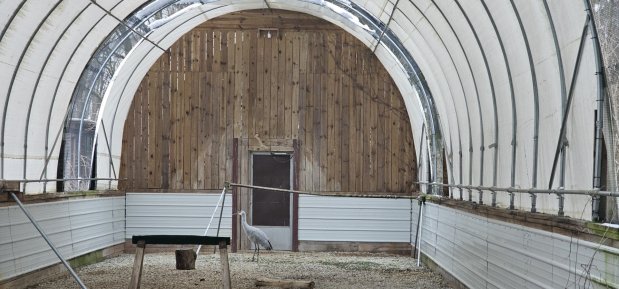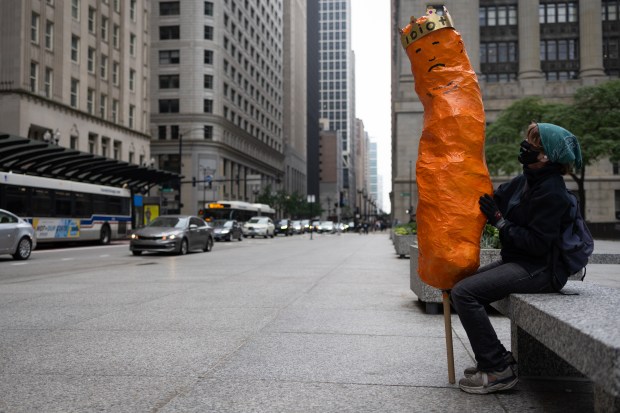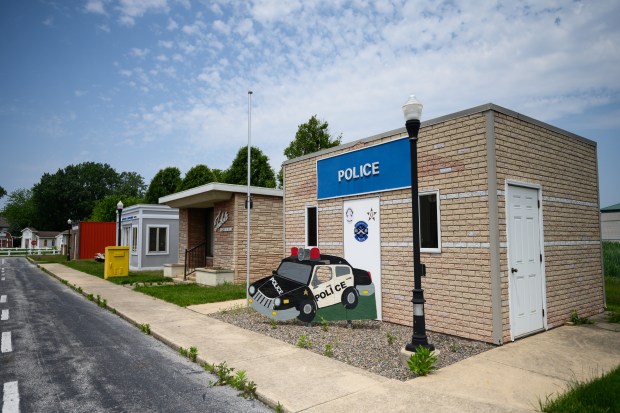Sandy, the 6-year-old sandhill crane who left Porter County last month for a new home at the Smithsonian National Zoo & Conservation Biology Institute in Washington, D.C., emerged from quarantine Thursday to finally be with other cranes permanently. She and the male and female sandhill cranes already living at the zoo put their bills to the sky and made some noise.
“It’s very loud. It’s described as a bugle,” said the Smithsonian’s curator of birds Sara Hallager. “It’s a very loud unison calling. She seemed happy to see other cranes.”
This togetherness with others of her kind was a long time in coming for Sandy. She was taken at about one year of age to the Utopia Wildlife Rehabilitators in Columbus after being hit by a car.
A badly damaged foot with an abscess that took a long time to heal meant Sandy became very social with people. “She was by herself here. We were her flock,” said director Kathleen Hershey.
When Utopia heard of a sandhill crane that was being rehabilitated at Humane Indiana Wildlife in Valparaiso they asked if Sandy could try cohabitating. She moved in successfully in late October, and the two were together briefly, but that bird was able to reintegrate into the wild while Sandy, with a damaged wing, could not.
“Sandhill cranes are seemingly very curious in nature,” said Nicole Harmon, director of Humane Indiana Wildlife. “And we saw that with Sandy. She immediately started digging through the shavings and straw (in her new Valparaiso habitat). They’re very active birds.”
Harmon got in contact with the Smithsonian, with which they already had a relationship for the transfer of songbirds, and they agreed to take her into their flock of two sandhill cranes, Ross’s geese and turkeys. Sandy arrived in Washington on Jan. 13 after volunteers from Humane Indiana Wildlife transported her in a special crate designed for her long frame.
It’s not yet known if Sandy is female since mature sandhill cranes look alike across genders. Some of Sandy’s feathers were collected Thursday and sent off for DNA analysis that will determine Sandy’s gender for sure, though Hallager said breeding is not a goal with rehabilitated sandhill cranes.
While the mid-Atlantic region which houses the Smithsonian isn’t a common home to sandhill cranes, they do see them migrating through on their north-to-south pathways. From the zoo’s perspective, the exhibit Sandy is now part of is an opportunity to educate Americans about native species and the story of migration.
“They know a lot about animals from other parts of the world, but they don’t know about animals from North America,” Hallager said of most Americans. “Birds in North America are declining at a pretty rapid rate.”
She said Sandy can now play a part in educating people on ways they can live that are bird-friendly so sandhill cranes can fit in. These omnivorous birds live 30 to 50 years in the wild, and closer to 50 years in captivity, so Sandy, after so many years alone, has many years of crane togetherness ahead of her.
“We’re thrilled to be able to give Sandy a home,” Hallager said. “We didn’t realize she was such a celebrity, so that was exciting.”
Shelley Jones is a freelance reporter for the Post-Tribune.





